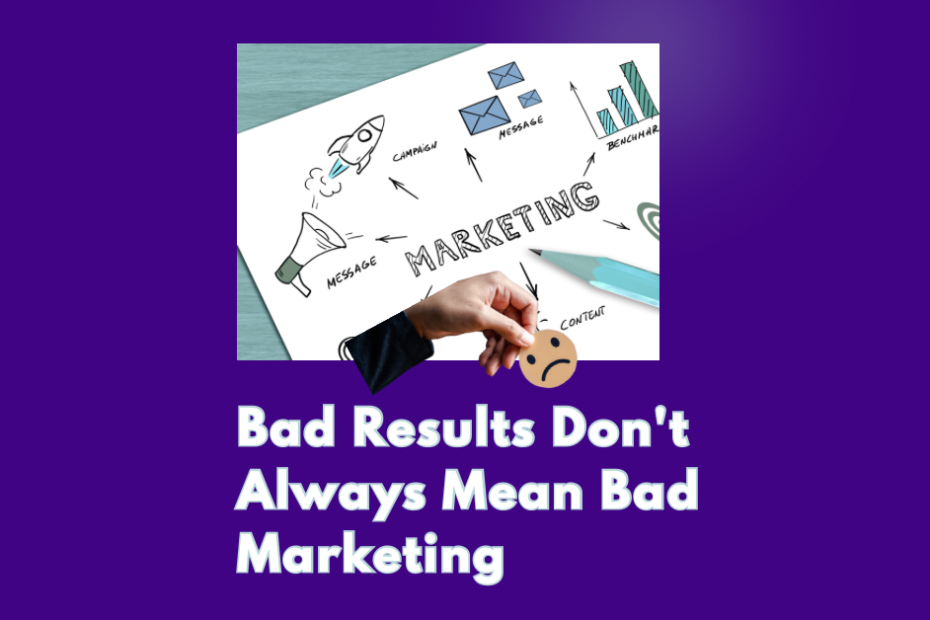You’re doing everything marketing. Posting three times a week. Running ads. Sending newsletters that took half your Tuesday to write. You’ve watched the tutorials, followed the frameworks, shown up consistently like everyone said you should.
And you’re getting fuck all results.
No sales. No enquiries. Not even a bloody email reply. Just you, your spreadsheet of content ideas, and the creeping certainty that you’re either invisible or completely delusional about your business.
So naturally, you’re wondering “what am I doing wrong?”
Here’s what’s actually happening, and it’s annoying but true
Sometimes nothing is wrong with your marketing.
I know. You wanted me to tell you it’s the font on your website or your Instagram bio. (and I can totally do that the way lol). Something fixable. Something you could sort out this afternoon and wake up tomorrow to a full inbox.
Bad results don’t automatically mean bad marketing. They might mean your timing is off. Or your offer isn’t urgent enough. Or your audience needs another three months before they trust you enough to hand over money.
Let me be clear, yes you can always improve. There’s always something to tighten, test, or chuck in the bin. But before you tear everything down and start again or sucked in numerous “gurus” offering to solve everything (which is what you’re thinking about, isn’t it?), let’s talk about what’s actually affecting your results.

1. Timing matters more than anyone admits
You can have brilliant copy, beautiful branding, and a product people genuinely need, and it still won’t work if they’re not ready to buy right now.
Think about your own behaviour. You probably follow brands for months, like their posts, think “yeah, that’s good,” and then… do nothing. Until one day, the timing is right and you buy. A case in point I spent actual months, that’s right months—looking at bread bannetons, danish dough whisks, bread lames etc. Saved posts. I am convinced the algorithm thought I was starting a bakery. Read reviews. Compared prices. Bought absolutely nothing. Then one Tuesday I woke up and bought an entire kit like a woman possessed. The marketing didn’t change. My brain just decided it was time.
Marketing isn’t mind control. You can’t force someone to want what you’re selling when they’ve just spent their budget, or they’re focused on something else, or they’re in the middle of moving house and can barely remember to eat.
You’re planting seeds. Some sprout next week. Some sprout next year. Some get eaten birds. That’s how it works.
2. Sometimes the problem isn’t the marketing, it’s the offer.
You might be promoting something people think is nice, but don’t need badly enough to actually do anything about.
That’s not a marketing problem. That’s a positioning problem.
Ask yourself, Does this solve an urgent, hair-on-fire problem, or does it just sound pleasant? Are you selling painkillers or vitamins? Because vitamins are a nice idea that people buy when they’re feeling flush and organised. Painkillers get bought immediately people in pain.
The difference between “I’m interested” and “here’s my credit card” is almost never about how clever your captions are. It’s about whether the thing you’re selling matters enough, right now.
3. People don’t trust you yet (and they shouldn’t)
If you’ve been consistent for six weeks and you’re annoyed nothing’s happened, I’m going to be blunt (surprise, surprise!) six weeks is nothing.
People don’t buy from strangers on the internet. They buy when they’re convinced you’re not going to waste their money, embarrass them, or disappear after they’ve paid. Building that confidence takes time.
Most of your audience is watching. They’re seeing whether you show up. Whether you know what you’re talking about. Whether other people trust you. They’re not ignoring you—they’re deciding.
This is especially true if you’re B2B or selling anything over a few hundred dollars. The decision cycle isn’t “see post, buy thing.” It’s “see post, forget about it, see another post, visit website, leave, come back three weeks later, read five more things, join the email list, ignore four emails, read one, think about it, then maybe—maybe—enquire.”
You’re not failing. You’re just in month two of a six-month process.
4. Stop blaming the algorithm for everything
Yes, reach matters. But plenty of people have tens of thousands of followers and can’t sell a damn thing. (see this post re algorithm)
What matters is whether your content resonates with the right people, not the most people. A hundred people who genuinely get what you do and have the problem you solve are worth more than ten thousand random scroll-eyeballs.
If you’re getting seen the wrong audience, more reach just means more of the wrong people. Better to have 50 engaged humans in your world than 5,000 tire-kickers who’ll never buy.
5. Business has slow periods and so do humans
There are quiet months. There are slow patches. There are school holidays, financial year ends, global news cycles, and inexplicable weeks where everyone just… stops buying things.
Big brands smooth this out with huge budgets and multiple revenue streams. You can’t. So you feel every dip like it’s a personal referendum on your worth as a business owner.
It’s not. It’s Tuesday in July. Or everyone’s on holiday. Or Mercury is in retrograde and nobody’s answering their bloody emails.
Don’t take every slow week as proof you’re rubbish. You’re not failing—you’re running a small business in the real world where things fluctuate.

Before you burn it all down, ask yourself this:
- What else could be affecting this result that has nothing to do with whether I’m “doing it right”?
- What do my people need more time or clarity around before they’ll act?
- Have I actually given this enough time to work, or am I panicking because it’s been three weeks?
Bad results are feedback. They’re data. They’re not a verdict on whether you should pack it in and get a job at Bunnings.
Your marketing might be absolutely fine. It just hasn’t had the right conditions to work yet.
So instead of changing everything in a panic, try changing one thing and giving it time. Test the offer. Sharpen the message. Talk to an actual customer about why they bought.
But for the love of god, stop stressing over bullshit that doesn’t matter. Not every quiet week means you’re doing it wrong. Sometimes it just means it’s Wednesday and people are busy.
Give it time. Give it room. And if you’re still getting nowhere in three months, then we’ll talk about what needs fixing.
You can find me here
